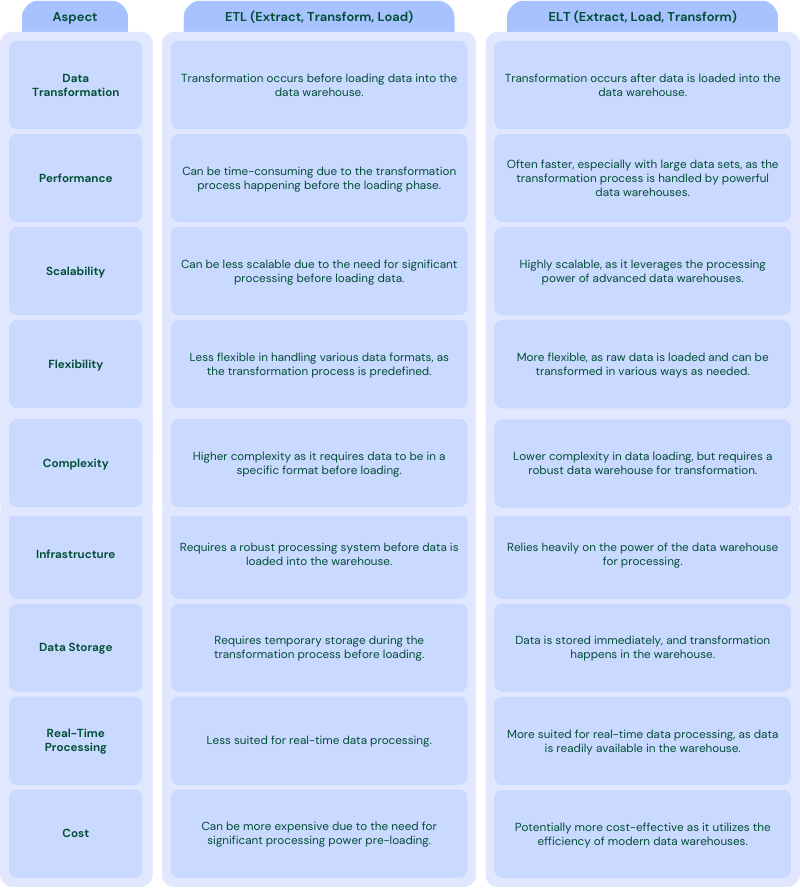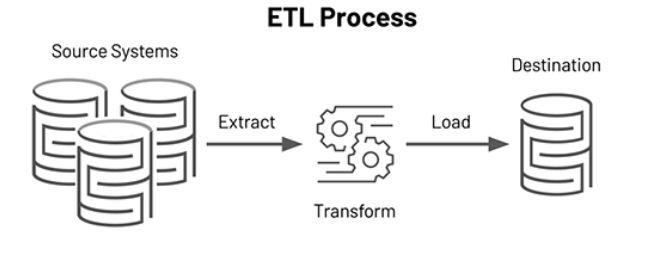Introduction
In the ever-evolving landscape of data processing, two methodologies stand out for processing vast amounts of data in Business Intelligence (BI) - Extract, Load, Transform (ELT) and Extract, Transform, Load (ETL). While they might seem similar at a glance, their applications in BI are distinct and significant.
Business Intelligence (BI) is a technology-driven process that uses data analysis to help organizations make more informed business decisions. At the heart of BI is the concept of turning vast amounts of raw data into meaningful information, which can then guide strategic and operational decision-making. This transformation from data to insight doesn't just happen spontaneously; it requires a meticulous process known as data processing.
This article aims to delve into the nuances of both ELT and ETL, comparing their roles and efficiencies in the realm of business intelligence.
How data is used in Business Intelligence (BI)?
Data is often referred to as the new oil, a valuable resource that can drive innovation and growth. In the context of BI, data is the foundational element. The quality, accuracy, and relevance of data directly impact the insights derived through BI tools.
However, raw data is typically unstructured and cluttered, making it nearly unusable in its original form. This is where data processing becomes indispensable.
Steps involved in Data Processing
Data processing in BI involves several key steps:
-
Data Collection: Gathering relevant data from various internal and external sources, including databases, social media, and IoT devices.
-
Data Cleaning: Removing inaccuracies and correcting errors in the data. This step ensures the reliability of the data that will be used for analysis.
-
Data Transformation: Converting data into a suitable format or structure for querying and analysis. This might involve normalizing, aggregating, or otherwise reorganizing the data.
-
Data Storage: Storing the processed data in a data warehouse or database, where it's organized efficiently for easy access and analysis.
-
Data Analysis: Using statistical tools and algorithms to analyze the stored data and extract meaningful patterns and trends.
-
Data Visualization: Presenting the analyzed data in an easily comprehensible format, such as charts, graphs, and dashboards, to aid in decision-making.
If you are looking for easy to use data visualization tools.
Check out our article where we rank top 7 data visualization libraries.
You won't believe which tool is at number 5. Check it out now.
What is ETL (Extract, Transform, Load)?
ETL, which stands for Extract, Transform, Load, is a traditional process in data warehousing. Data is extracted from various sources, transformed into a format suitable for analysis, and then loaded into a data warehouse.
Source: databricks
-
Extract: The first step involves extracting data from various source systems. These sources can be databases, CRM systems, marketing tools, or any other data repositories. The data extracted is often raw and unstructured.
-
Transform: After extraction, this data undergoes a transformation process. This step is crucial as it involves cleaning, standardizing, and restructuring the data into a format suitable for analysis. It might include operations like sorting, aggregating, joining, and more, ensuring the data meets the necessary quality and format standards.
-
Load: Finally, the transformed data is loaded into a target data warehouse or database. This is where the data is stored and made available for querying and analysis. The loading process needs to be optimized to ensure data integrity and efficient retrieval.
ETL is a traditional approach, often used when it's critical to ensure the data is clean and conforming to specific standards before it's stored in the data warehouse.
What is ELT (Extract, Load, Transform)?
ELT, or Extract, Load, Transform, represents a newer approach in data handling where data is first extracted and loaded into a target data warehouse before any transformation occurs.
Source: dbt
-
Extract: Similar to ETL, the process begins with extracting data from various sources. The focus here is also on collecting as much data as needed from different data sources.
-
Load: In ELT, the extracted data is loaded directly into the data warehouse or storage system without undergoing any transformation. This means the data is stored in its raw, unprocessed form.
-
Transform: Unlike ETL, the transformation of data occurs after it has been loaded into the data warehouse. Modern data warehouses are powerful enough to handle and process large volumes of raw data efficiently. Transformation happens in-place and on-demand, depending on the specific requirements of the analysis or reporting.
ELT is a more recent approach, gaining popularity with the rise of cloud-based data warehouses. It is often preferred for big data applications due to its efficiency in handling large volumes of data and its flexibility in managing various data formats.
ETL vs ELT: How is ETL Different from the ELT Process?

Get Your Custom ETL Solution Now
Don’t let complex data scenarios slow you down. Get Your Custom ETL Solution Now from DataHen's team of experienced professionals. Contact us to explore how we can enhance your data processing with precision and speed.
Click Here: Custom ETL Services for Enterprises
Impact of ETL and ELT on Business Intelligence
Impact of ETL and ELT on Data Accuracy
The ETL process, with its emphasis on transforming data before loading it into the data warehouse, allows for thorough cleansing and normalization. This can significantly enhance data accuracy, as inconsistencies and errors are addressed before the data is used for BI purposes. The rigorous transformation process in ETL can lead to higher data quality, which is crucial for accurate BI reporting and analysis.
In ELT, raw data is loaded directly into the data warehouse, and transformation occurs afterward. While this approach is more efficient in handling large volumes of data, it might initially compromise data accuracy, as the cleansing and normalization happen later in the process. However, with the advancements in modern data warehouses, ELT can still maintain high data accuracy, provided the data warehouse is equipped with powerful data transformation and validation tools.
Impact of ETL and ELT on Reporting
Given that data is pre-processed and transformed, ETL can provide highly structured and consistent data, which is ideal for standard reporting purposes. The transformation stage in ETL ensures that data adheres to business rules and reporting standards, resulting in reliable and consistent reports.
ELT allows for more flexibility in reporting, especially when dealing with diverse and unstructured data sources. Since data transformation occurs within the data warehouse, ELT can adapt to changing reporting requirements more quickly. However, this flexibility might require additional processing time when generating reports, especially if new transformation logic needs to be applied.
Impact of ETL and ELT on Analytics
The structured nature of the ETL process can be advantageous for traditional analytics, where consistency and data quality are paramount. ETL is well-suited for scenarios where analytics require a high degree of data integrity and standardization. However, the time-intensive transformation process can be a limitation for real-time analytics.
The speed and scalability of the ELT process are beneficial for advanced analytics, particularly when dealing with large datasets and real-time analytics. The ability to quickly load and later transform data makes ELT ideal for dynamic and exploratory analytics, such as data mining and machine learning applications, where immediate access to large volumes of raw data is beneficial.
How to Scrape Emails From Websites
Unlock email marketing potential by learning about email scrapers. Effortless web scraping to precisely scrape emails & transform web data into growth. Learn the techniques on how to run a flawless email scraper below.
Click Here: Web Scraping for Email Marketing
Use Cases for ETL
Legacy Systems Integration in Banking:
A bank needs to integrate data from various legacy systems for regulatory reporting. These systems include old databases and applications that use different data formats and standards.
ETL is ideal here due to its strong capabilities in data cleansing and transformation. It ensures that the diverse data from these legacy systems is standardized and cleansed before being loaded into a central data warehouse, maintaining data integrity and compliance with regulatory standards.
Healthcare Data Analysis:
A healthcare provider aims to analyze patient data to improve treatment outcomes. This data includes sensitive information and needs to comply with regulations like HIPAA. Learn more
The transformation stage in ETL is crucial for ensuring data privacy and compliance. By transforming and anonymizing data before it's loaded into the data warehouse, ETL helps maintain patient confidentiality while making the data suitable for analysis.
Use Cases for ELT
Real-Time Data Analytics in E-Commerce:
An e-commerce company wants to analyze customer behavior in real-time to provide personalized recommendations and improve customer experience.
ELT’s ability to quickly load raw data into a data warehouse and transform it as needed is crucial for real-time analytics. This approach allows the e-commerce company to rapidly process large volumes of data and gain immediate insights into customer behavior.
Big Data Processing for Social Media Analytics:
A marketing firm wishes to analyze large-scale social media data to understand market trends and consumer sentiments.
Given the enormous volume and variety of social media data, ELT is more suitable due to its scalability and flexibility. The firm can efficiently load massive amounts of unstructured data (like tweets, posts, and comments) into a data warehouse and use the warehouse's processing power to perform complex transformations and analyses.
Conclusion
The choice between ETL (Extract, Transform, Load) and ELT (Extract, Load, Transform) is a strategic one that significantly impacts the efficiency and effectiveness of Business Intelligence (BI) initiatives.
While both share core components, they offer distinct advantages and cater to different data processing and analytics needs. ETL, known for transforming data before warehouse loading, is ideal for scenarios demanding high data quality, consistency, and compliance, such as in financial reporting or healthcare analytics. Its structured process ensures data reliability, making it a mainstay in traditional BI setups.
Conversely, ELT suits the demands of businesses handling large, varied data sets, excelling in real-time analytics and big data applications like e-commerce and social media analytics, where speed and adaptability are key. It utilizes the advanced processing power of modern data warehouses for dynamic data transformation.
As BI continues to evolve, the combined strengths of ETL and ELT remain vital in leveraging data to inform business strategies and insights.
Explore More: Uncover the potential of email crawling in "Email Crawling: The Secret to Business Growth".
Learn how it revolutionizes marketing campaigns. Read Now.


